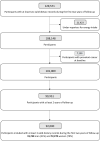Food additive emulsifiers and cancer risk: Results from the French prospective NutriNet-Santé cohort
- PMID: 38349899
- PMCID: PMC10863884
- DOI: 10.1371/journal.pmed.1004338
Food additive emulsifiers and cancer risk: Results from the French prospective NutriNet-Santé cohort
Abstract
Background: Emulsifiers are widely used food additives in industrially processed foods to improve texture and enhance shelf-life. Experimental research suggests deleterious effects of emulsifiers on the intestinal microbiota and the metabolome, leading to chronic inflammation and increasing susceptibility to carcinogenesis. However, human epidemiological evidence investigating their association with cancer is nonexistent. This study aimed to assess associations between food additive emulsifiers and cancer risk in a large population-based prospective cohort.
Methods and findings: This study included 92,000 adults of the French NutriNet-Santé cohort without prevalent cancer at enrolment (44.5 y [SD: 14.5], 78.8% female, 2009 to 2021). They were followed for an average of 6.7 years [SD: 2.2]. Food additive emulsifier intakes were estimated for participants who provided at least 3 repeated 24-h dietary records linked to comprehensive, brand-specific food composition databases on food additives. Multivariable Cox regressions were conducted to estimate associations between emulsifiers and cancer incidence. Overall, 2,604 incident cancer cases were diagnosed during follow-up (including 750 breast, 322 prostate, and 207 colorectal cancers). Higher intakes of mono- and diglycerides of fatty acids (FAs) (E471) were associated with higher risks of overall cancer (HR high vs. low category = 1.15; 95% CI [1.04, 1.27], p-trend = 0.01), breast cancer (HR = 1.24; 95% CI [1.03, 1.51], p-trend = 0.04), and prostate cancer (HR = 1.46; 95% CI [1.09, 1.97], p-trend = 0.02). In addition, associations with breast cancer risk were observed for higher intakes of total carrageenans (E407 and E407a) (HR = 1.32; 95% CI [1.09, 1.60], p-trend = 0.009) and carrageenan (E407) (HR = 1.28; 95% CI [1.06, 1.56], p-trend = 0.01). No association was detected between any of the emulsifiers and colorectal cancer risk. Several associations with other emulsifiers were observed but were not robust throughout sensitivity analyses. Main limitations include possible exposure measurement errors in emulsifiers intake and potential residual confounding linked to the observational design.
Conclusions: In this large prospective cohort, we observed associations between higher intakes of carrageenans and mono- and diglycerides of fatty acids with overall, breast and prostate cancer risk. These results need replication in other populations. They provide new epidemiological evidence on the role of emulsifiers in cancer risk.
Trial registration: ClinicalTrials.gov NCT03335644.
Copyright: © 2024 Sellem et al. This is an open access article distributed under the terms of the Creative Commons Attribution License, which permits unrestricted use, distribution, and reproduction in any medium, provided the original author and source are credited.
Conflict of interest statement
The authors have declared that no competing interests exist.
Figures




References
-
- Calixto Andrade G, Julia C, Deschamps V, Srour B, Hercberg S, Kesse-Guyot E, et al. Consumption of Ultra-Processed Food and Its Association with Sociodemographic Characteristics and Diet Quality in a Representative Sample of French Adults. Nutrients. 2021;13:682. doi: 10.3390/nu13020682 - DOI - PMC - PubMed
MeSH terms
Substances
Associated data
Grants and funding
LinkOut - more resources
Full Text Sources
Other Literature Sources
Medical
Research Materials
Miscellaneous

